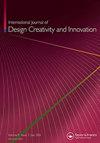Utilizing optical illusions for creative form finding
IF 2.5
Q4 ENGINEERING, MANUFACTURING
International Journal of Design Creativity and Innovation
Pub Date : 2020-05-18
DOI:10.1080/21650349.2020.1763204
引用次数: 2
Abstract
ABSTRACT Geometrical illusions are an intrinsic part of human perception but largely ignored in product design. This paper analyzes user perception of a functional, ubiquitous object – the plastic bottle – to provide new insights on how geometrical illusions can be harnessed for creative form finding based on the designer’s intent. Through the examination of 24 different bottles, a range of characteristics and properties are classified. A subset of five representative bottles are then used to explore user perceptions of form, relating these to geometrical design features. The main findings, based on observational tests and user feedback, suggest an overestimation of volumes in bottles that are taller, have wider shoulder angles, or have less occluded patterns. Furthermore, a number of prevalent features are considered in relation to optical illusions which can affect perception. Using these findings, design strategies and guidelines are suggested for creative form development and the utilization of geometrical illusions more widely.利用视觉错觉进行创造性的形式寻找
几何错觉是人类感知的内在组成部分,但在产品设计中往往被忽视。本文分析了用户对一个功能性的、无处不在的物体——塑料瓶的感知,为如何根据设计师的意图利用几何错觉来寻找创造性的形式提供了新的见解。通过检查24个不同的瓶子,一系列的特征和性能进行分类。然后使用五个代表性瓶子的子集来探索用户对形式的感知,并将其与几何设计特征联系起来。基于观察性测试和用户反馈的主要发现表明,对较高、肩部角度较宽或遮挡图案较少的瓶子的容量估计过高。此外,一些普遍的特征被认为与影响感知的视错觉有关。利用这些发现,提出了创造性形式发展和更广泛地利用几何错觉的设计策略和指导方针。
本文章由计算机程序翻译,如有差异,请以英文原文为准。
求助全文
约1分钟内获得全文
求助全文
来源期刊

International Journal of Design Creativity and Innovation
ENGINEERING, MANUFACTURING-
CiteScore
3.80
自引率
27.80%
发文量
15
期刊介绍:
The International Journal of Design Creativity and Innovation is an international publication that provides a forum for discussing the nature and potential of creativity and innovation in design from both theoretical and practical perspectives. Design creativity and innovation is truly an interdisciplinary academic research field that will interest and stimulate researchers of engineering design, industrial design, architecture, art, and similar areas. The journal aims to not only promote existing research disciplines but also pioneer a new one that lies in the intermediate area between the domains of systems engineering, information technology, computer science, social science, artificial intelligence, cognitive science, psychology, philosophy, linguistics, and related fields. The journal covers, but is not restricted to, the following topics: ·Theories on Design Creativity and Innovation ·Cognition of Design Creativity ·Innovative Process ·Inventive Process ·Analogical Reasoning for Design Creativity and Innovation ·Design Synthesis ·Method and Tools for Design Creativity and Innovation ·Representation of Design Creativity and Innovation ·Education for Design Creativity and Innovation ·Concept Generation and Inspiration.
 求助内容:
求助内容: 应助结果提醒方式:
应助结果提醒方式:


